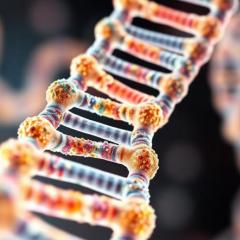The Human Genetics team at The University of Queensland Diamantina Institute have successfully used a new gene mapping approach for patients affected by severe skeletal abnormalities.
Skeletal dysplasias are a group of diseases that cause abnormalities in the skeleton’s growth and function. This can lead to problems such as abnormal height and/or limb length, difficulty with reproduction and decreased life span. Families affected by skeletal dysplasias are usually very small in number, which can make it difficult to find the disease-causing gene for that family.
Associate Professor Andreas Zankl, a clinical geneticist from The University of Queensland Centre for Clinical Research, developed a Bone Dysplasia registry for patients and their families - the first of its kind in Australia. Through the registry, the UQDI team of researchers met a family with two young daughters affected by a severe form of dwarfism.
The team used next-generation sequencing to simultaneously study the four immediate family members and compare their exomes - the coding section of the genes – to each other and against the reference sequence from the international Human Genome Project. They were able to discover which gene within the family caused the abnormality. Impressively, the mapping process took only a few weeks. The UQDI researchers then successfully determined how the genetic abnormality caused the skeletal disease.
In the past, researchers could only sequence and compare a few genes at a time, which was expensive and time consuming. For example, UQDI researchers had spent a decade finding the responsible gene for another type of skeletal dysplasia, fibrodysplasia ossificans progressiva. In contrast, next-generation sequencing technology can provide more rapid results for mapping genes in these particular types of diseases. However, despite this breakthrough in progress, Associate Professor Emma Duncan reiterates it’s still an intensive process.
“Typically, we all have a number of small genetic differences – we find approximately 20,000 on average just in our coding regions when compared with the Human Genome sequence - so it’s still a very involved process to work out which one is the disease-causing mutation.”
“For this family, it’s been a huge relief to find out why their little girls have this devastating skeletal disorder, and understanding the genetics has helped them in their planning for any future pregnancies,” said Professor Matthew Brown.
With the success of their next generation sequencing approach, the team have also researched another skeletal dysplasia case which involved five unrelated individuals, comparing their exomes with each other and with the Human Genome Project. By examining just this small number of affected people, the responsible gene has been identified. The researchers at the UQDI will continue to map unknown genes for skeletal dysplasias and for other likely single-gene inherited diseases.
The paper has been published in the Public Library of Science (PLoS). The success of this discovery was due to funding by the Australian Cancer Research Foundation, NAB and NHMRC, The Rebecca L Cooper Foundation, the Royal Children’s Hospital Research Foundation and an ANZ Medical Research Grant. Finally, the team of dedicated UQDI researchers: Professor Matthew Brown, Associate Professor Andreas Zankl, Dr Evgeny Glazov, Dr Graeme Clark, Dr Gethin Thomas, Dr Tony Kenna and Associate Professor Emma Duncan.
The UQDI would like to thank the patients and their families who generously participated in the project.



